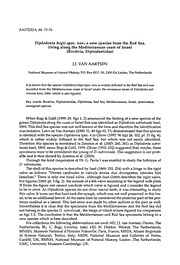Table Of ContentBASTERIA, 68: 73-76
Diplodonta bogii spec, nov.: a new species from theRed Sea,
living along the Mediterraneancoastof Israel
(Bivalvia, Diplodontidae)
J.J. vanAartsen
National Museum ofNaturalHistory, P.O.Box 9517, NL 2300RALeiden,The Netherlands
ItisshownthatthespeciesDiplodontabogiispec.nov.is widelydiffused intheRedSeaandwas
recorded from the Mediterranean coast ofIsraelunder the erroneousnameofDiplodontasub-
rotunda Issel, 1869,which isalso figured.
Key words: Bivalvia,Diplodontidae,Diplodonta, Red Sea,Mediterranean,Israel,systematics,
immigrantspecies.
WhenBogi &Galil (1999:29, figs 1,2)announcedthefinding ofanew speciesofthe
genusDiplodonta alongthecoastofIsraelthiswas identifiedasDiplodonta subrotunda Issel,
1869.ThisRedSeaspecies wasnotwellknown atthetimeandthereforetheidentification
wastentative.LateronVanAartsen(2000:51,49figs 10,11)demonstratedthatthisspecies
is identicalwiththespeciesDiplodonta spec.4inOliver (1992:96figs 26,102,pi. 21 fig.4),
which is rather widely diffusedin the Red Sea, but which was not easily identified.
DThereforethiis sppecies is mlenotionedindZenetosoetal. (200n3: 260, 26t1)asa subro-
tundaIssel, 1869,sensu Bogi & Galil, 1999. Oliver(1992:102)suggested that,maybe, these
specimens weretobe consideredtheyoungof D. subrotunda.Thissuggestion is notprob-
ableand is thusdeniedbyZenetosetal.(2003).
Through thekindcooperation of Dr.G. Pavia Iwas enabledtostudy theholotype of
D. subrotunda.
The shellof thisspecies is describedby Issel (1869:253,254)withahinge in theright
valve as follows: "Dentes cardinales in valvula dextra duo divergentes, laterales bini
lamellosi."There is only onefossil valve,although Issel (1869) describestheright valve,
but figures (1869:pi.3fig.2) theoutsideofaleftvalveaccording tothelegend withplate
3! Fromthefigure onecannot concludewhichvalveis figured andI considerthelegend
to bein error. AsDiplodonta species donot show lateralteeth, itwasinteresting tostudy
this valve.Itturns outthatIsseltookthenymph, whichwasnotwellpreserved in thisfos-
sil, tobeanadditionallateral.Atthesametime heconsideredtheposteriorpartofthepos-
terior cardinalasalateral.Thislast errorwas madeby otherauthors in thepast aswell.
Nevertheless itis clear that thespecimens from theMediterraneanand theRed Seadid
not belong tothespecies D. subrotunda, thehingeofwhichisherefigured forcomparison
as figs 1-2. Theconclusionis thattheMediterraneanandRed Seaspecimens belong toa
new species whichis heredescribed.
Forcollectionsthefollowing abbreviationsareused:AD, J.J. vanAartsen,Dieren,The
Netherlands; BL, C. Bogi, Livorno, Italy; HD, H. Dekker, Winkel, The Netherlands;
MNHN,Museum National d'HistoireNaturelle,Paris, France; MRSN, MuseoRegionale
di Scienze Naturali, Torino, Italy; NMW, National Museum and Galleries of Wales,
Cardiff, UK; RMNH, National Museum of Natural History, Leiden ,The Netherlands;
UMC,University Museum Cambridge, UK.
74 BASTERIA, Vol. 68,No. 4-6, 2004
Additionalabbreviations:p,paired valves; v, valve.
Diplodonta bogii spec.nov.(figs 3,4)
DiplodontatumidaH.Adams [inpart.?];Lamy, 1916: 189.
DiplodontatumidaH.Adams;Moazzo,1939:93.
Diplodontaspec.;Oliver, 1992:96, textfig.26,pi.21 fig.4.
Diplodontaspec.;Hoenselaar &Dekker, 1998: 205.
Diplodontasubrotunda Issel; Bogi&Galil,1999:29, figs1,2.
Diplodontatumida (H.Adams);Dekker&Orlin,2000:11.
Diplodonta subrotundasensuBogi&Galil;VanAartsen,2001:51, 49 figs 10,11
Diplodontaravayensis[sic] Sturany; Zuschin &Oliver,2003:110,figs26.3-5.
Diplodontacf. subrotundaIssel;Zenetos etal., 2003: 260,fig.
NotPhlyctidermatumida(H.Adams);Oliver, 1992:102,pi.21 fig. 5.Astudyofthefiguredspecimenshows
ittobelongtoMysia (Lajonkairia)elegans(H. Adams,1871);thereis asyntype(BMNH 1871.3.22.11)
whichwasstudied too.
Material(holotypeand paratypes). - Egypt: ZeitBay (NMW 1984.071.00004/1v[= Oliver,1992,pi.
21 fig.4]);Suez (NMW 1955.158.11402/1v; MNHN/1p& 13v);Great BitterLake (RMNH43894-43909,
exColin Beets[SeeBeets, 1953],sta.GB.05/7v,GB.08/5v, GB.09/2v,GB.10/7v +(holotypeRMNH 99414),
GB.14/7v, GB.18/2v, GB.19/4v, GB.24/lp+lv, GB.25/2v, GB.26/2v, GB.28/lp+5v, GB.29/2v, GB.33/3v,
GB.35/8v,GB.45/3v,GB.46/lv);GreatBitterLake,HD 17112p, HD 1712lp+lvleg.C.Beets, 1950.Djibouti
(MNHN/7v).SaudiArabia: Musselamiwah Bay (NMW 1992.001.00014/2v).Yemen: Aden(MNHN/10v).
RedSea: (UMC/7p).Israel,Mediterranean coast:BL4p+10v(+manyjuveniles),AD18098A2p+5v(juv).
Description. - Shell nearly round and rathertumid.The outer surfaceonly shows
somegrowth-lines butno realsculpture canbe detected.Thehinge consistsoftwo diver-
gentcardinals, theanterior in theleftvalveand theposterior in theright valveare split
into two equal parts. There are no laterals. The ligament is wholly internal and there
seems tobe no nymph. Thelargest specimen is 10* 9 mm. The holotype measures 8><7
mm.
Differentiation.- Thenewspecies differsfrom D. subrotundainanumberofcharac-
ters. Mostimportant is thepresence ofanymph fortheexternalligament inD. subrotun-
da whereasin D. bogii such afeature is notpresentand theligament seems tobe wholly
internal. Secondly,thenewspecies reaches amaximumdimensionofabout 10mmwhere-
as Dsubrotundareaches morethan doublethat dimension.Thirdly, it is notedthatin D.
subrotundathehinge-plate is clearlydifferentiatedfromtheanteriordorsalmarginwhere-
as thehinge-platelies in thesame plane as theshell margin inD. bogii (compare figs 1-2
with figs 3-4) .
Thepresentspecies is undoubtedly citedin theliteratureunderthenameDiplodonta
tMumida (H. Adams, 1871). Hoywever,Adams (s1871:791,792, pii. 48 figa.16) described
tumidaas " M.testaoblique rotundata, tenui,inequilaterali, striolis confertisradiantibus
et concentricis obsolete decussata; umbonibus antemedianis, tumidis, prominentibus;
regione postica paulum latiore; margine ventralioblique arcuato. Long. 12,alt. 11, lat.8
mill."Neitherthesculpture (radial as wellasconcentric), thedimensionsnorthepromi-
nent umbonescanbeapplied toD. bogii spec.nov.
ThereforeAdams's namecannot beaccepted forthisspecies, notwithstanding thefact
that specimens of D. bogii of 6 to 7 mm are present in the M'Andrew collection in
Cambridge, fromwherethespecies Mysia tumida was described.
Van Aartsen: Diplodonta bogii spec. Nov. 75
Figs 1-2.DiplodontasubrotundaIssel, 1869.SpecimenfromEgypt,GreatBitterLake, RMNH(excolln C.
Beets), height 12mm. 1. Leftvalve hinge.2 Right valve hinge. Note remains ofligamentfastened to
nymph.
Figs3-4. Diplodontabogii spec. nov.HolotypefromEgypt, GreatBitterLake,RMNH (excolln C.Beets),
height7mm. 3.Leftvalveinside. 4.Right valveinside. Note absenceofnymph.
ACKNOWLEDGEMENTS
The helpof Dr G. Pavia (MRSN), Mrs V.Heros and Dr Ph. Bouchet (MNHN),Mrs
A.H. Wood and Dr P.G. Oliver (NMW) as well as Dr R. Preece (UMC) is gratefully
acknowledged. Thephotographs werekindlymadeby J.Goud(RMNH).
76 BASTERIA, Vol.68, No. 4-6, 2004
REFERENCES
AARTDSEN, J.J.van,i2000.pEuropeanmlarinoeMollusca:dNotesonleosswell-knownn species. tXVI. a
eddystonia(Marshall,1895),with notesonthe otherEuropeanDiplodontaspecies. — La Conchiglia
32(297):46-51,60-61.
ADAMS,H., 1871. Descriptionsoftwenty-six newspeciesofshells collected byRobertM'Andrew,Esq.,
inthe RedSea.-Proceedings oftheZoologicalSociety ofLondon (1870):788-793.
BEETS, C., 1953. Notes on the dredgingin the Great Bitter Lake ofthe Suez Canal. — Zoologische
Mededelingen,Leiden 32: 97-106
BOGI,C.,&B.S.GALIL, 1999.New findingsalongthe Israeli coast. — LaConchiglia31(292):29-32.
DEKKER, H.,& Z.ORLIN,2000.Check-list ofRed SeaMollusca. —Spirula47(supplement):1-46.
HOENSELAAR, H. J., & H. DEKKER, 1998. Molluscs oftheGreatBitterLake,Suez Canal, Egypt, col-
lected by C.Beetsin 1950. — Basteria62:197-214.
ISSEL, A., 1869. Malacologia del Mar Rosso, ricerche zoologiche e paleontologiche. Biblioteca
Malacologica.:i-xi, 1-387.Pisa.
LAMY,E.,1916.Les lucinesetlesdiplodontesdela MerRouge(d'apreslesmateriaux recueillis par M.le
Dr Jousseaume).— Bulletin duMuseum d'Histoirenaturelle,Paris 22(4): 183-190.
MOAZZO,P.G., 1939. Mollusquestestacesmarins duCanal deSuez. — Memoires del'lnstitutd'Egypte
38: 1-287.
OLIVER,P.G., 1992.Bivalved seashells ofthe RedSea: 1-330.Wiesbaden-Cardiff.
ZENETOS, A., S. GOFAS, G. RUSSO & J. TEMPLADO, 2003. CIESM atlas ofexotic species in the
Mediterranean. Vol.3.Molluscs: 1-376.Monaco.
ZUSCHIN, M., & P. G. OLIVER, 2003. Bivalves and bivalve habitats in the northern Red Sea. The
Northern Bay of Safaga (Red Sea, Egypt): An actuopalaeontological approach. VI. Bivalvia.
Naturhistorisches MuseumWien: 1-304.Wien.

